Immune Monitoring Unit

Prof. Dr. med. Michael Platten
Department Head
We perform deep profiling of antigen-specific immune responses to understand successful anti-tumor immunity in cancer patients
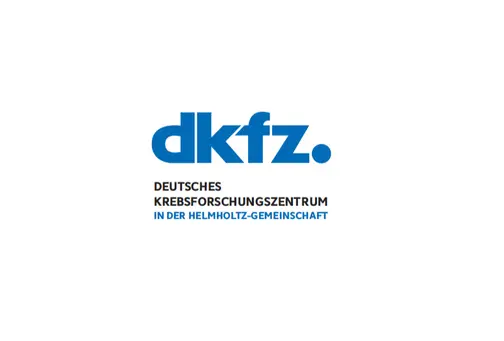
State of the art immune monitoring of clinical trials
The Immune Monitoring Unit (IMU) offers basic as well as state-of-the-art immunological analysis for investigator-initiated or externally-sponsored oncological trials of all phases.
We accompany you from study idea to the final report or publication. We know that sample quality is key - we therefore support all aspects of sample collection to make the most out of valuable patient blood and tissues.
Our team of immunology experts is constantly upskilled to incorporate the latest research findings into our immune monitoring portfolio. Standardized work-flows according to SOPs make our evaluations reliable and comparable.
IMU PORTFOLIO
During trial design, IMU can advise on relevant sampling time points and the types of biomaterials (e.g. serum vs. plasma) needed for planned immune assays.
Based on the goals of your study, we can help to select relevant analytical methods.
IMU offers broad assay portfolio, ranging from standard immune monitoring assays such as ELISpot, ELISA, FACS and Luminex to sequening-based methods focused on analysis of adaptive immune repertoires (AIR-Seq).
For optimal results across patient cohorts, we take great care to assess assay sensitivity and reproducibility.
Depending on trial needs, we are happy to establish or implement new assays.
→ Learn more about IMMUNE ASSAYS
As part of our QUALITY MANAGEMENT system, all IMU assays adhere to standardized procedures. For an external assessment of our performance, IMU regularly participates in proficiency panels.
Depending on trial needs, assays can be performed in a GCLP-compliant fashion.
While preparing the analytical study plan, immune response and positivity criteria will be defined for each assay.
We will analyze and summarize immune assay data and provide it in the formats required by differenty stake-holders, such as data-management, study-PI, translational researcher or bioinformatician.
Raw data will be stored at IMU and can be made available for further analysis.
We can create written reports on our results, including data visualization.
See PUBLICATIONS with IMU contribution
IMU is experienced in prossessing human blood and tissue samples for various down-stream assays.
Based on the planned analysis, we will compile an analytical study plan as well as a laboratory manual covering all aspects of sample processing, shipment, storage and logistics.
To ensure standardized sample processing, we organize sample processing at external sites according to our standard operating procedures (SOPs).
All biosamples can be collected and stored at IMU, where we keep records on each sample aliquot.
→ Learn more about SAMPLE TYPES
Sample quality is the key to reliable results. To ensure consistent sample quality in multi-centric trials, we can train external labs in sample processing procedures.
IMU has established a constantly expanding bank of EBV-transformed B lymphoblastoid cell lines (B-LCLs). All LCL lines have been HLA-typed and thus represent a great source of antigen-presenting cells for various assays.
Please note that handling of EBV-transformed LCLs falls under the German infection protection law (Infektionsschutzgesetz) and can only be performed by holders of an adequate permission.
SAMPLE TYPES
Blood collected in EDTA containing tubes (any manufacturer) is compatible with DNA/RNA-isolation, e.g. for sequencing-based applications such as HLA-typing.
Note: Alternative collection tubes containing e.g. RNA stabilizers might be preferable, depending on the analyis planned.
In most cases, collection of 5-10 mL of EDTA blood suffices.
Blood collected in lithium heparin tubes (any manufacturer) is our favorite source of peripheral blood mononuclear cells (PBMC). After densitiy gradient centrifugation, PBMC can by analyzed for phenotype and/or functional properties, for example by flow cytometry, ELISpot or (single cell) sequencing.
Analysis of fresh and frozen PBMC samples is possible. For reproducibility and centralized analysis, batch-wise assays of PBMC cryopreserved in DMSO-containing medium are preferred.
PBMC numbers required for cellular assays (examples):
- 0.3 - 1 x 10e6 cells per flow cytometry sample (plus more cells for assay controls)
- 8-10 x 10e6 cells for an ex vivo Elispot against a single-vaccine antigen (including controls)
- 3-6 x 10e6 cells for an epitope-specific expansion culture against a single antigen (including controls)
Note: about 1 x 10e6 PBMC can be isolated per 1 mL of blood. Cell loss after freeze-thawing of PBMC needs to be considered. => Depending on the analysis planned, most studies will need to collect 30-100 mL of lithium heparin blood per patient visit for immune monitoring.
Serum is the supernatant of coagulated (clotted) blood. It is suitable for assays such antibody or cytokine ELISA, as well as Luminex.
In most cases, collection of 5-10 mL of blood suffices for serum isolation. Sample processing should commence within 2h of venipuncture.
Plasma, the liquid component of blood, is obtained by centrifugation of anti-coagulated blood samples.
It is suitable for assays such as Luminex and detection of cell-free DNA / circulating tumor DNA.
In most cases, collection of 5-10 mL of blood suffices for plamsa isolation. Samples processing should commence within 1h of venipuncture.
Fresh (tumor) tissue - after dissection and/or dissociation - can be used for a variety of analyses, such as in vitro expansion of tumo-infiltrating lymphocytes, characterization of tumor and immune cells by flow cytometry and/or single-cell RNA and/or TCR sequencing.
Cryopreserved (tumor) tissue (also known as fresh-frozen or snap-frozen) can be used for histology-based methods, exome and transcriptome sequencing, as well as immune-receptor repertoire analysis (bulk AIR-seq).
Formalin-fixed paraffin-embedded (FFPE) tissue, as often available via the pathology department or through biobanks, is suitable for histology-based methods, proteomics and sequencing-based approaches. Note that the fixation process affects nucleid acid quality and is particularely limiting for RNA-based sequencing technologies.
Similar to PBMC, cerebrospinal fluid (CSF) can be used for cellular analyses based for example on flow cytometry or (deep and single-cell) RNA/TCR sequencing.
Note that CSF normally contains very few cells (<5 cells/µL), limiting analyis, unless a disease-related increase in cells within the CSF is expected.
Stool samples can be collected for microbiome analysis.
IMMUNE ASSAYS
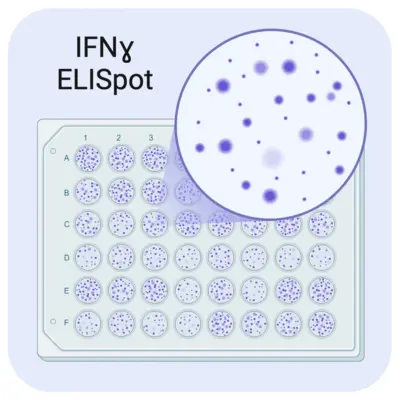
Enzyme Linked Immuno Spot (ELISpot) assays are used to measure cytokine or antibody secretion. The assays sensitivity allows detection of individual antigen-reactive T cells in PBMC samples.
IFN-gamma ELISpot is therefore frequently used to determine immunogenicity after vaccination.
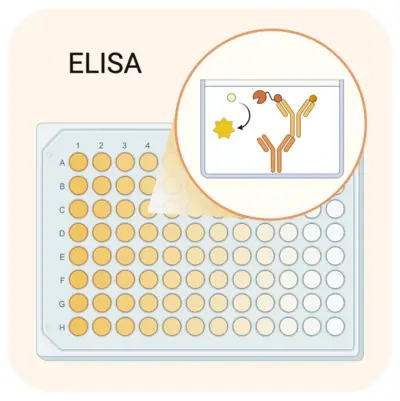
Enzyme-linked Immunosorbent Assay (ELISA) can be used to detect many different analytes such as proteins, viral particles, hormones and toxines.
IMU uses ELISA for cytokine detection and to measure antigen-specific antibodies in patient serum.

Flow Cytometry, also called fluorescence-activated cell scanning (FACS), allows multiplexed phenotypic and functional analysis of single cells.
IMU has established a large number of staining panels for deep phenotyping of circulating and tumor-infiltrating immune cells. We also use FACS to measure antigen-specific T cell responses by intracellular cytokine staining, detection T cell activation or degranulation markers, as well as MHC multimer staining.
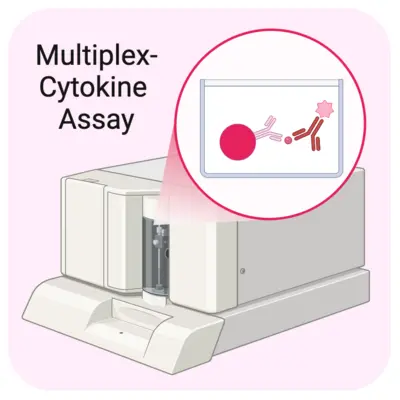
Luminex-based assays are solid phase sandwich immunoassays that make use of analyte specific antibodies coupled to color-coded beads.
High multiplexing capacity allows detection of many analytes in a small sample volume. IMU commonly uses a 27-plex cytokine/chemokine assay to determine immune signatures in patient plasma or serum.
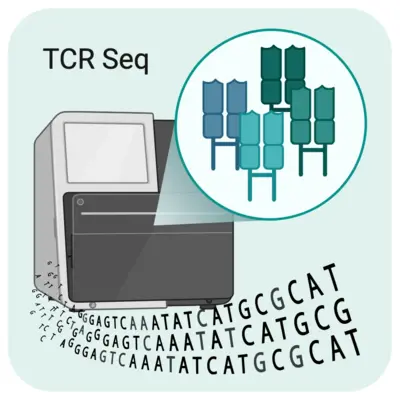
Adaptive immune receptor sequencing (AIR-SEP) is used to analyse T cell receptor (TCR) or B cell receptor (BCR) repertoires in blood or tissue samples.
Each T cell expresses only one TCR. TCR sequencing enables analysis of the TCR repertoire at the time of blood or tumor sampling and allows tracking of individual clonotypes (cells sharing the same TCR) over time. This enables for example the detection vaccine-induced clonal expansion of antigen-specific T cells in the blood, or the tracing of such TCRs to primary and metastatic tumors.
Novel high-throughput technologies allow combined detection of TCR, gene expression profile and additional features for > 10.000 individual cells, allowing for unprecedented insight into therapie-induced changes and tumor-immune interactions.
IMU offers
- bulk RNA-based TCR seqeuncing covering all 4 TCR chains (TRA, TRB, TRG and TRD) from blood and tissue samples, as well as cultured cells. Parallel BCR sequencing (IGH, IGK and IGL) is possible.
- high-throughput single-cell TCR sequencing (BD Rhapsody, in-house, high cell input possible; 10X Genomics, via DKFZ single-cell open lab). Combination with single-cell RNA-sequencing, cellular barcoding and barcoded-antibodes is possible.

We can perform many functional immune assays based on e.g. T cell cytokine production, proliferation or degranulation, which can be tailored to individual trials/projects.
INSTRUMENTATION
| Assay | Instrument | Description |
|---|---|---|
| Flow Cytometry | FACS Lyric (BD) | multiparametric flow cytometry (12 colors) |
| ELISpot | ImmunoSpot (CTL) | brightfield plate reading |
| scSequencing | Rhapsody (BD) | microwell-based cell partitioning |
| Luminescence/Fluorescence | SpectraMax Mini (Molecular Devices) | ELISA and more |
| Electroporation | 4D-Nucleofector (Lonza) | DNA/RNA electroporation |
| Molecular biology | Tape Station (Agilent), Qubit (ThermoFisher) | DNA/RNA quality control |
QUALITY MANAGEMENT
Comparable data and analyzes with consistent results are crucially important in the context of clinical studies. The IMU therefore operates according to validated Standard Operating Procedures (SOPs) that cover experimental procedures, but also many other operational aspects.
In addition to this internal quality assurance, we regularly take part in ring tests and proficiency panels in order to gain additional external feedback on our performance. As a member of the CIMT Immunoguiding Program (CIP), we interact with other scientists to implement the latest standardization. This is achieved not least by close contact with the individual manufacturing companies.
Depending on trial needs, we can offer validated assays and operate according to GCLP standards.
CLINICAL TRIALS supported by the IMU
The trial will address safety and tolerability of the combination of the IDH1R132H-specific vaccine with checkpoint blockade and seeks to explore predictive biomarkers for response to checkpoint blockade in post-treatment tumor tissue.
Contribution of IMU: Tumor, PBMC, serum and plasma processing for IFNᵞ-ELISpot assays and anti-IDHR132H-ELISA as part of the secondary endpoint analysis; cytokine screening, flow cytometric profiling of immune cell subsets and TCR repertoire analysis for evaluation of explorative endpoints and translational research. Coordination of sample logistics and distribution.
Status: recruitment closed
NK-92/5.28.z consists of NK92 cells modified to express a Her2-neu targeting chimeric antigen receptor (CAR). The objective of this clinical study is to evaluate the safety and tolerability of intracranial injection of NK-92/5.28.z and to determine the maximum tolerated dose or maximum feasible dose (MFD).
Contribution of IMU: CSF and tumor processing, bulk and single-cell AIR-Seq.
Status: open
The trial will assess save dosing of CVGBM mRNA vaccine in patients who had surgery for glioblastoma or astrocytoma.
Contribution of IMU: PBMC and serum processing
Status: open
AIO-YMO/TRK-0415 (FORCE) is a Phase 2, open-label of nivolumab, patients with metastatic non-squamous NSCLC with the necessity of radiotherapy of a metastatic site (e.g. bone) in 2nd-line or 3rd-line treatment for study group A and patients with metastatic non-squamous NSCLC without the necessity of radiotherapy in 2nd-line or 3rd-line treatment for study Group B.
Contribution of IMU: PBMC, serum and plasma isolation, IFNγ-ELISpot Assay, FACS of checkpoint Inhibitory molecules, Luminex and TCR sequencing as part of the accompanying translational research.
status: recruitment closed
The aim of this trial is to determine preliminary activity of the combination treatment with nivolumab and entinostat in children and adolescents with high risk refractory/relapsed/progressive tumors harboring a high mutational load, high PD-L1 mRNA expression or focal MYC(N) amplification and explore activity in biomarker low tumors (low mutational load, low PD-L1 mRNA expression and non-MYC(N) amplified)
Contribution of IMU: PBMC, serum and plasma isolation, flow cytometric analysis of immune biomarkers in fresh blood samples, multiplexed cytokine profiling, coordination of sample logistics and distribution.
status: recruiting
The INTERCEPT H3 trial combines H3K27M peptide vaccination with radiotherapy and checkpoint inhibitor treatment in patients with diffuse midline gliomas.
Contribution of IMU: Coordination of sample logisitics and collection, training of external labs, processing of PBMC, serum, plasma, CSF and tumor for immune assays, including IFNγ ELISpot assays for immunogenicity assessment (primary endpoint), flow-cytometry, ELISA and TCR repertoire analysis for secondary endpoints and translational research.
status: open
This trial makes use of a patient-individual salmonella Ty21a carrier-based DNA plasmid vaccine that can be orally administered and enrolls patients of different tumor entities.
Contribution of IMU: Training of external labs, logistic of PBMC collection, evaluation of antigen-specific T cell responses.
status: open
This trial makes use of a patient-individual salmonella Ty21a carrier-based DNA plasmid vaccine that can be orally administered. NECVAX-NEO1-02-INT enrolls patients with solid tumors who also receive standard-of-care treatment with PD-1 or PD-L1 monoclonal antibody inhibitor therapy.
Contribution of IMU: Training of external labs, logistic of PBMC collection, PBMC isolation, evaluation of antigen-specific T cell responses.
status: open
This trial makes use of a patient-individual salmonella Ty21a carrier-based DNA plasmid vaccine that can be orally administered and enrolls patients with newly diagnosed breast cancer. The vaccine is administered parallel to chemotherapy and an immunostimulatory antibody prior to surgical tumor resection, with optional prolongation of treatment after surgery.
Contribution of IMU: Training of external labs, logistic of PBMC collection, PBMC isolation, evaluation of antigen-specific T cell responses.
status: open
The NOA-16 trial is the first-in-man trial of the IDH1 (isocitrate dehydrogenase type 1) peptide vaccine targeting the IDH1R132H mutation (amino acid exchange from arginine to glutamine at position 132 of IDH1). The aim of this trial is to evaluate the safety and tolerability of and immune response to the IDH1 peptide vaccine in patients with IDH1R132H-mutated, WHO grade III-IV gliomas.
Contribution of IMU: PBMC, serum and plasma processing for and IFNγ-ELISpot assay and IDH1R132H antibody response via ELISA as part of the primary endpoint analysis.
see Platten et al., Nature 2021 (https://pubmed.ncbi.nlm.nih.gov/33762734/) for results.
A multicenter phase I/II trial to evaluate the efficacy and safety combining oral T cell vaccination targeting VEGRF2 (VXM01) with anti-PD-L1 checkpoint inhibitor therapy (Avelumab) in recurrent Glioblastoma patients following tumor resection and radiochemotherapy containing temozolomide.
Contribution of IMU: Processing of PBMC, and tissue samples as part of the exploratory endpoint analysis. IFN-γ ELIspot, flow cytometry Immunophenotyping and TCR repertoire profiling to monitor vaccine induced T cell responses.
status: closed
TEAM
Our team of immunology experts is constantly upskilled to incorporate the latest research findings into our immune monitoring portfolio. Contact us to discuss your planned study!
-

Prof. Dr. med. Michael Platten
Head of Immune Monitoring Unit
-

Dr. Isabel Poschke
Team Leader IMU
-

Alexander Ernst
TA - TCR Sequencing
-

Ingrid Hülsmeyer
biologist - ELISpot, Luminex
-

Simone Jünger
TA - FACS, ELISA, QM
-

Samira Moreen Sachse
TA - Molecular Biology, Cell culture
-

Akanksha Shukla
TA - TCR Discovery
PUBLICATIONS
Safi S, Krzykalla J, Hoffmann H, Benner A, Bischoff H, Eichhorn M, Kriegsmann M, Poschke I, Stögbauer F, Umansky L, Mogler C, Weichert W, Winter H, Beckhove P, Muley T.
Tan CL, Lindner K, Boschert T, Meng Z, Rodriguez Ehrenfried A, De Roia A, Haltenhof G, Faenza A, Imperatore F, Bunse L, Lindner JM, Harbottle RP, Ratliff M, Offringa R, Poschke I, Platten M, Green EW.
Boschert T, Kromer K, Lerner T, Lindner K, Haltenhof G, Tan CL, Jähne K, Poschke I, Bunse L, Eisele P, Grassl N, Mildenberger I, Sahm K, Platten M, Lindner JM, Green EW.
Meyer M, Parpoulas C, Barthélémy T, Becker JP, Charoentong P, Lyu Y, Börsig S, Bulbuc N, Tessmer C, Weinacht L, Ibberson D, Schmidt P, Pipkorn R, Eichmüller SB, Steinberger P, Lindner K, Poschke I, Platten M, Fröhling S, Riemer AB, Hassel JC, Roberti MP, Jäger D, Zörnig I, Momburg F.
Grassl N, Sahm K, Süße H, Poschke I, Bunse L, Bunse T, Boschert T, Mildenberger I, Rupp AK, Ewinger MP, Lanz LM, Denk M, Tabatabai G, Ronellenfitsch MW, Herrlinger U, Glas M, Krex D, Vajkoczy P, Wick A, Harting I, Sahm F, von Deimling A, Bendszus M, Wick W, Platten M.
Grassl N, Poschke I, Lindner K, Bunse L, Mildenberger I, Boschert T, Jähne K, Green EW, Hülsmeyer I, Jünger S, Kessler T, Suwala AK, Eisele P, Breckwoldt MO, Vajkoczy P, Grauer OM, Herrlinger U, Tonn JC, Denk M, Sahm F, Bendszus M, von Deimling A, Winkler F, Wick W, Platten M, Sahm K.
Lu KH, Michel J, Kilian M, Aslan K, Qi H, Kehl N, Jung S, Sanghvi K, Lindner K, Zhang XW, Green EW, Poschke I, Ratliff M, Bunse T, Sahm F, von Deimling A, Wick W, Platten M, Bunse L.
Bunse L, Rupp AK, Poschke I, Bunse T, Lindner K, Wick A, Blobner J, Misch M, Tabatabai G, Glas M, Schnell O, Gempt J, Denk M, Reifenberger G, Bendszus M, Wuchter P, Steinbach JP, Wick W, Platten M.
Liebers N, Speer C, Benning L, Bruch PM, Krämer I, Meissner J, Schnitzler P, Kräusslich HG, Dreger P, Müller-Tidow C, Dietrich S, Poschke I
Platten M, Bunse L, Wick A, Bunse T, Le Cornet L, Harting I, Sahm F, Sanghvi K, Tan CL, Poschke I, Green E, Justesen S, Behrens GA, Breckwoldt MO, Freitag A, Rother LM, Schmitt A, Schnell O, Hense J, Misch M, Krex D, Stevanovic S, Tabatabai G, Steinbach JP, Bendszus M, von Deimling A, Schmitt M, Wick W.
van Tilburg CM, Witt R, Heiss M, Pajtler KW, Plass C, Poschke I, Platten M, Harting I, Sedlaczek O, Freitag A, Meyrath D, Taylor L, Balasubramanian GP, Jäger N, Pfaff E, Jones BC, Milde T, Pfister SM, Jones DTW, Kopp-Schneider A, Witt O.
Poschke IC, Hassel JC, Rodriguez-Ehrenfried A, Lindner KAM, Heras-Murillo I, Appel LM, Lehmann J, Lövgren T, Wickström SL, Lauenstein C, Roth J, König AK, Haanen JBAG, van den Berg J, Kiessling R, Bergmann F, Flossdorf M, Strobel O, Offringa R.
Buhl JL, Selt F, Hielscher T, Guiho R, Ecker J, Sahm F, Ridinger J, Riehl D, Usta D, Ismer B, Sommerkamp AC, Martinez-Barbera JP, Wefers AK, Remke M, Picard D, Pusch S, Gronych J, Oehme I, van Tilburg CM, Kool M, Kuhn D, Capper D, von Deimling A, Schuhmann MU, Herold-Mende C, Korshunov A, Brummer T, Pfister SM, Jones DTW, Witt O, Milde T.
Safi S, Yamauchi Y, Stamova S, Rathinasamy A, Op den Winkel J, Jünger S, Bucur M, Umansky L, Warth A, Herpel E, Eichhorn M, Winter H, Hoffmann H, Beckhove P.
Ge Y, Böhm HH, Rathinasamy A, Xydia M, Hu X, Pincha M, Umansky L, Breyer C, Hillier M, Bonertz A, Sevko A, Domschke C, Schuetz F, Frebel H, Dettling S, Herold-Mende C, Reissfelder C, Weitz J, Umansky V, Beckhove P
Bunse L, Green EW, Platten M
Green EW, Bunse L, Bozza M, Sanghvi K, Platten M.
Lanz TV, Pröbstel AK, Mildenberger I, Platten M, Schirmer L.
Hilf N, Kuttruff-Coqui S, Frenzel K, Bukur V, Stevanović S, Gouttefangeas C, Platten M, Tabatabai G, Dutoit V, van der Burg SH, Thor Straten P, Martínez-Ricarte F, Ponsati B, Okada H, Lassen U, Admon A, Ottensmeier CH, Ulges A, Kreiter S, von Deimling A, Skardelly M, Migliorini D, Kroep JR, Idorn M, Rodon J, Piró J, Poulsen HS, Shraibman B, McCann K, Mendrzyk R, Löwer M, Stieglbauer M, Britten CM, Capper D, Welters MJP, Sahuquillo J, Kiesel K, Derhovanessian E, Rusch E, Bunse L, Song C, Heesch S, Wagner C, Kemmer-Brück A, Ludwig J, Castle JC, Schoor O, Tadmor AD, Green E, Fritsche J, Meyer M, Pawlowski N, Dorner S, Hoffgaard F, Rössler B, Maurer D, Weinschenk T, Reinhardt C, Huber C, Rammensee HG, Singh-Jasuja H, Sahin U, Dietrich PY, Wick W.
Get in touch with us

